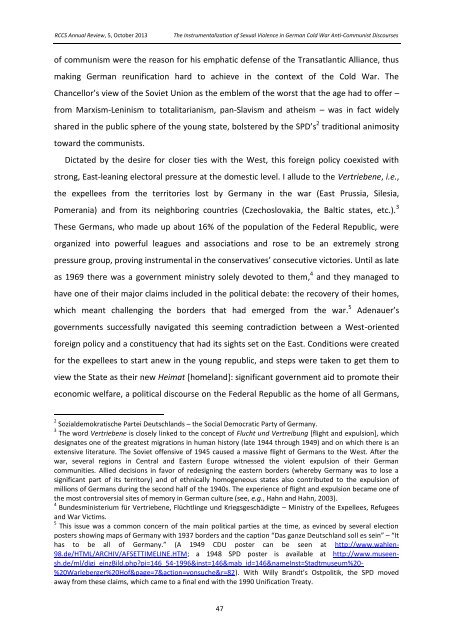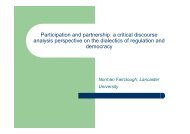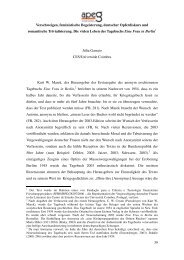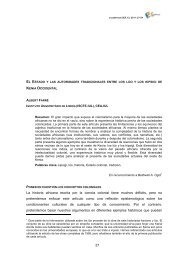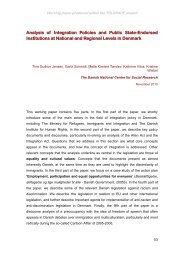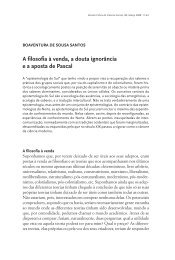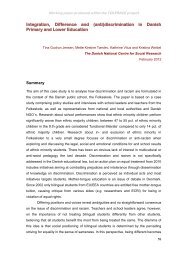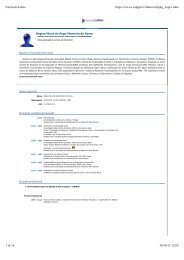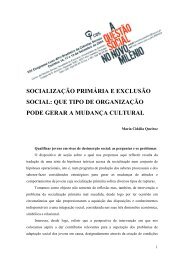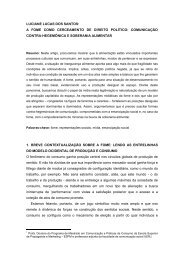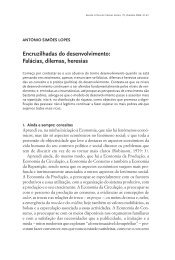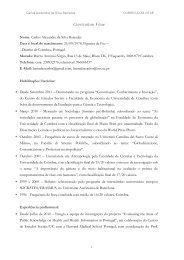The Instrumentalization of Sexual Violence in German Cold War Anti ...
The Instrumentalization of Sexual Violence in German Cold War Anti ...
The Instrumentalization of Sexual Violence in German Cold War Anti ...
You also want an ePaper? Increase the reach of your titles
YUMPU automatically turns print PDFs into web optimized ePapers that Google loves.
RCCS Annual Review, 5, October 2013<br />
<strong>The</strong> <strong>Instrumentalization</strong> <strong>of</strong> <strong>Sexual</strong> <strong>Violence</strong> <strong>in</strong> <strong>German</strong> <strong>Cold</strong> <strong>War</strong> <strong>Anti</strong>-Communist Discourses<br />
<strong>of</strong> communism were the reason for his emphatic defense <strong>of</strong> the Transatlantic Alliance, thus<br />
mak<strong>in</strong>g <strong>German</strong> reunification hard to achieve <strong>in</strong> the context <strong>of</strong> the <strong>Cold</strong> <strong>War</strong>. <strong>The</strong><br />
Chancellor’s view <strong>of</strong> the Soviet Union as the emblem <strong>of</strong> the worst that the age had to <strong>of</strong>fer –<br />
from Marxism-Len<strong>in</strong>ism to totalitarianism, pan-Slavism and atheism – was <strong>in</strong> fact widely<br />
shared <strong>in</strong> the public sphere <strong>of</strong> the young state, bolstered by the SPD’s 2 traditional animosity<br />
toward the communists.<br />
Dictated by the desire for closer ties with the West, this foreign policy coexisted with<br />
strong, East-lean<strong>in</strong>g electoral pressure at the domestic level. I allude to the Vertriebene, i.e.,<br />
the expellees from the territories lost by <strong>German</strong>y <strong>in</strong> the war (East Prussia, Silesia,<br />
Pomerania) and from its neighbor<strong>in</strong>g countries (Czechoslovakia, the Baltic states, etc.). 3<br />
<strong>The</strong>se <strong>German</strong>s, who made up about 16% <strong>of</strong> the population <strong>of</strong> the Federal Republic, were<br />
organized <strong>in</strong>to powerful leagues and associations and rose to be an extremely strong<br />
pressure group, prov<strong>in</strong>g <strong>in</strong>strumental <strong>in</strong> the conservatives’ consecutive victories. Until as late<br />
as 1969 there was a government m<strong>in</strong>istry solely devoted to them, 4 and they managed to<br />
have one <strong>of</strong> their major claims <strong>in</strong>cluded <strong>in</strong> the political debate: the recovery <strong>of</strong> their homes,<br />
which meant challeng<strong>in</strong>g the borders that had emerged from the war. 5 Adenauer’s<br />
governments successfully navigated this seem<strong>in</strong>g contradiction between a West-oriented<br />
foreign policy and a constituency that had its sights set on the East. Conditions were created<br />
for the expellees to start anew <strong>in</strong> the young republic, and steps were taken to get them to<br />
view the State as their new Heimat [homeland]: significant government aid to promote their<br />
economic welfare, a political discourse on the Federal Republic as the home <strong>of</strong> all <strong>German</strong>s,<br />
2 Sozialdemokratische Partei Deutschlands – the Social Democratic Party <strong>of</strong> <strong>German</strong>y.<br />
3 <strong>The</strong> word Vertriebene is closely l<strong>in</strong>ked to the concept <strong>of</strong> Flucht und Vertreibung [flight and expulsion], which<br />
designates one <strong>of</strong> the greatest migrations <strong>in</strong> human history (late 1944 through 1949) and on which there is an<br />
extensive literature. <strong>The</strong> Soviet <strong>of</strong>fensive <strong>of</strong> 1945 caused a massive flight <strong>of</strong> <strong>German</strong>s to the West. After the<br />
war, several regions <strong>in</strong> Central and Eastern Europe witnessed the violent expulsion <strong>of</strong> their <strong>German</strong><br />
communities. Allied decisions <strong>in</strong> favor <strong>of</strong> redesign<strong>in</strong>g the eastern borders (whereby <strong>German</strong>y was to lose a<br />
significant part <strong>of</strong> its territory) and <strong>of</strong> ethnically homogeneous states also contributed to the expulsion <strong>of</strong><br />
millions <strong>of</strong> <strong>German</strong>s dur<strong>in</strong>g the second half <strong>of</strong> the 1940s. <strong>The</strong> experience <strong>of</strong> flight and expulsion became one <strong>of</strong><br />
the most controversial sites <strong>of</strong> memory <strong>in</strong> <strong>German</strong> culture (see, e.g., Hahn and Hahn, 2003).<br />
4 Bundesm<strong>in</strong>isterium für Vertriebene, Flüchtl<strong>in</strong>ge und Kriegsgeschädigte – M<strong>in</strong>istry <strong>of</strong> the Expellees, Refugees<br />
and <strong>War</strong> Victims.<br />
5 This issue was a common concern <strong>of</strong> the ma<strong>in</strong> political parties at the time, as ev<strong>in</strong>ced by several election<br />
posters show<strong>in</strong>g maps <strong>of</strong> <strong>German</strong>y with 1937 borders and the caption “Das ganze Deutschland soll es se<strong>in</strong>” – “It<br />
has to be all <strong>of</strong> <strong>German</strong>y.” (A 1949 CDU poster can be seen at http://www.wahlen-<br />
98.de/HTML/ARCHIV/AFSETTIMELINE.HTM; a 1948 SPD poster is available at http://www.museen-<br />
sh.de/ml/digi_e<strong>in</strong>zBild.php?pi=146_54-1996&<strong>in</strong>st=146&mab_id=146&nameInst=Stadtmuseum%20-<br />
%20<strong>War</strong>leberger%20H<strong>of</strong>&page=7&action=vonsuche&r=82). With Willy Brandt’s Ostpolitik, the SPD moved<br />
away from these claims, which came to a f<strong>in</strong>al end with the 1990 Unification Treaty.<br />
47


